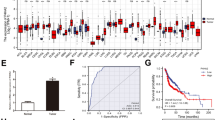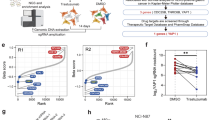Abstract
Background
The role of Feline sarcoma-related protein (Fer) in various cancers has been extensively studied, but its specific involvement and underlying mechanisms in the progression of endometrial carcinoma (EC) are yet to be fully understood.
Methods
The expression levels of Fer were assessed in EC tissues and cell lines using real-time quantitative PCR and western blot analysis. CCK-8 assay, Edu staining, transwell assays, and flow cytometry, were conducted to evaluate the impact of Fer on EC cells. Furthermore, a mice xenograft model and immunohistochemistry (IHC) staining were utilized for in vivo analysis. The levels of Ras, pMek1/2, and pErk1/2 were determined by western blot assay. Ras-MAPK signaling pathway inhibitor was utilized to study the regulatory role of Fer on EC cells.
Results
Our findings revealed that Fer exhibited upregulation in both EC tissues and cell lines, concomitant with the activation of the Ras-MAPK signaling pathway. Silencing of Fer resulted in the suppression of cell proliferation, migration, invasion, and Ras-MAPK signaling pathway, while promoted hypoxia-induced apoptosis in RL95-2 and KLE cells. Fer overexpression stimulated cell proliferation, migration, invasion, and Ras-MAPK signaling pathway in Ishikawa and AN3-CA cells, which were reversed after treatment with either Ras or MAPK inhibitor. Moreover, silencing of Fer suppressed tumor growth and downregulated the expression of Ki-67, Ras, pMek1/2, and pErk1/2, but had no significant effect on Mek1/2 and Erk1/2, while upregulated caspase-3 expression in vivo.
Conclusion
In summary, the upregulation of Fer in EC cells resulted in the enhancement of cell proliferation, migration, and invasion through the activation of the Ras-MAPK signaling pathway.






Similar content being viewed by others
Data availability
All data are available from the corresponding author with reasonable request.
References
Bray F, Ferlay J, Soerjomataram I, Siegel RL, Torre LA, Jemal A (2018) Global cancer statistics 2018: GLOBOCAN estimates of incidence and mortality worldwide for 36 cancers in 185 countries. CA Cancer J Clin 68:394–424. https://doi.org/10.3322/caac.21492
Zhou J, Lin Y, Yang X, Shen B, Hao J, Wang J, Wang J (2022) Metabolic disorders sensitise endometrial carcinoma through endoplasmic reticulum stress. Cell Mol Biol Lett 27:110. https://doi.org/10.1186/s11658-022-00412-x
Mitamura T, Dong P, Ihira K, Kudo M, Watari H (2019) Molecular-targeted therapies and precision medicine for endometrial cancer. Jpn J Clin Oncol 49:108–120. https://doi.org/10.1093/jjco/hyy159
Luna C, Balcacer P, Castillo P, Huang M, Alessandrino F (2021) Endometrial cancer from early to advanced-stage disease: an update for radiologists. Abdom Radiol (NY) 46:5325–5336. https://doi.org/10.1007/s00261-021-03220-7
Greer P (2002) Closing in on the biological functions of Fps/Fes and Fer. Nat Rev Mol Cell Biol 3:278–289. https://doi.org/10.1038/nrm783
Ben-Dor I, Bern O, Tennenbaum T, Nir U (1999) Cell cycle-dependent nuclear accumulation of the p94fer tyrosine kinase is regulated by its NH2 terminus and is affected by kinase domain integrity and ATP binding. Cell Growth Differ 10:113–129
Heath RJ, Insall RH (2008) F-BAR domains: multifunctional regulators of membrane curvature. J Cell Sci 121:1951–1954. https://doi.org/10.1242/jcs.023895
Miyata Y, Kanda S, Sakai H, Greer PA (2013) Feline sarcoma-related protein expression correlates with malignant aggressiveness and poor prognosis in renal cell carcinoma. Cancer Sci 104:681–686. https://doi.org/10.1111/cas.12140
Hu X, Zhang Z, Liang Z, Xie D, Zhang T, Yu D, Zhong C (2017) Downregulation of feline sarcoma-related protein inhibits cell migration, invasion and epithelial-mesenchymal transition via the ERK/AP-1 pathway in bladder urothelial cell carcinoma. Oncol Lett 13:686–694. https://doi.org/10.3892/ol.2016.5459
Li H, Ren Z, Kang X, Zhang L, Li X, Wang Y, Xue T, Shen Y, Liu Y (2009) Identification of tyrosine-phosphorylated proteins associated with metastasis and functional analysis of FER in human hepatocellular carcinoma cells. BMC Cancer 9:366. https://doi.org/10.1186/1471-2407-9-366
Ding W, Fan Y, Jia W, Pan X, Han G, Zhang Y, Chen Z, Lu Y, Wang J, Wu J, Wang X (2021) FER regulated by miR-206 promotes hepatocellular carcinoma progression via NF-kappaB signaling. Front Oncol 11:683878. https://doi.org/10.3389/fonc.2021.683878
Zoubeidi A, Rocha J, Zouanat FZ, Hamel L, Scarlata E, Aprikian AG, Chevalier S (2009) The Fer tyrosine kinase cooperates with interleukin-6 to activate signal transducer and activator of transcription 3 and promote human prostate cancer cell growth. Mol Cancer Res 7:142–155. https://doi.org/10.1158/1541-7786.MCR-08-0117
Luo X, Yang Z, Liu X, Liu Z, Miao X, Li D, Zou Q, Yuan Y (2019) Clinicopathological significances of Feline sarcoma-related protein and beta2-adrenoceptor expression in pancreatic ductal adenocarcinomas. Int J Clin Exp Pathol 12:3390–3398
Malumbres M, Barbacid M (2003) RAS oncogenes: the first 30 years. Nat Rev Cancer 3:459–465. https://doi.org/10.1038/nrc1097
Spiegel J, Cromm PM, Zimmermann G, Grossmann TN, Waldmann H (2014) Small-molecule modulation of Ras signaling. Nat Chem Biol 10:613–622. https://doi.org/10.1038/nchembio.1560
Burotto M, Chiou VL, Lee JM, Kohn EC (2014) The MAPK pathway across different malignancies: a new perspective. Cancer 120:3446–3456. https://doi.org/10.1002/cncr.28864
Zhao YL, Zhong SR, Zhang SH, Bi JX, Xiao ZY, Wang SY, Jiao HL, Zhang D, Qiu JF, Zhang LJ, Huang CM, Chen XL, Ding YQ, Ye YP, Liang L, Liao WT (2019) UBN2 promotes tumor progression via the Ras/MAPK pathway and predicts poor prognosis in colorectal cancer. Cancer Cell Int 19:126. https://doi.org/10.1186/s12935-019-0848-4
Liu Z, Zhao M, Jiang X, Zhang Y, Zhang S, Xu Y, Ren H, Su H, Wang H, Qiu X (2022) Upregulation of KLHL17 promotes the proliferation and migration of non-small cell lung cancer by activating the Ras/MAPK signaling pathway. Lab Invest 102:1389–1399. https://doi.org/10.1038/s41374-022-00806-7
Sangrar W, Shi C, Mullins G, LeBrun D, Ingalls B, Greer PA (2015) Amplified Ras-MAPK signal states correlate with accelerated EGFR internalization, cytostasis and delayed HER2 tumor onset in Fer-deficient model systems. Oncogene 34:4109–4117. https://doi.org/10.1038/onc.2014.340
Ayakannu T, Taylor AH, Konje JC (2020) Selection of endogenous control reference genes for studies on type 1 or type 2 endometrial cancer. Sci Rep 10:8468. https://doi.org/10.1038/s41598-020-64663-4
Zhang L, Wan Y, Zhang Z, Jiang Y, Gu Z, Ma X, Nie S, Yang J, Lang J, Cheng W, Zhu L (2021) IGF2BP1 overexpression stabilizes PEG10 mRNA in an m6A-dependent manner and promotes endometrial cancer progression. Theranostics 11:1100–1114. https://doi.org/10.7150/thno.49345
Felix AS, Yang HP, Bell DW, Sherman ME (2017) Epidemiology of endometrial carcinoma: etiologic importance of hormonal and metabolic influences. Adv Exp Med Biol 943:3–46. https://doi.org/10.1007/978-3-319-43139-0_1
Mehazri L, Shpungin S, Bel S, Nir U (2021) Loss of Fer jeopardizes metabolic plasticity and mitochondrial homeostasis in lung and breast carcinoma cells. Int J Mol Sci. https://doi.org/10.3390/ijms22073387
Hao QL, Heisterkamp N, Groffen J (1989) Isolation and sequence analysis of a novel human tyrosine kinase gene. Mol Cell Biol 9:1587–1593. https://doi.org/10.1128/mcb.9.4.1587-1593.1989
Zhang Y, Xiong X, Zhu Q, Zhang J, Chen S, Wang Y, Cao J, Chen L, Hou L, Zhao X, Hao P, Chen J, Zhuang M, Li D, Fan G (2022) FER-mediated phosphorylation and PIK3R2 recruitment on IRS4 promotes AKT activation and tumorigenesis in ovarian cancer cells. Elife. https://doi.org/10.7554/eLife.76183
Fan G, Zhang S, Gao Y, Greer PA, Tonks NK (2016) HGF-independent regulation of MET and GAB1 by nonreceptor tyrosine kinase FER potentiates metastasis in ovarian cancer. Genes Dev 30:1542–1557. https://doi.org/10.1101/gad.284166.116
Hu X, Guo Z, Xu J, Mei X, Bi M, Jiang F, Yu D, Zhong C (2019) Role of feline sarcoma-related protein in the viability and apoptosis of bladder cancer cells. Mol Med Rep 19:5219–5226. https://doi.org/10.3892/mmr.2019.10204
Suh JS, Lee HJ, Nam H, Jo BS, Lee DW, Kim JH, Lee JY, Chung CP, Lee G, Park YJ (2017) Control of cancer stem cell like population by intracellular target identification followed by the treatment with peptide-siRNA complex. Biochem Biophys Res Commun 491:827–833. https://doi.org/10.1016/j.bbrc.2017.05.148
Craig AW, Greer PA (2002) Fer kinase is required for sustained p38 kinase activation and maximal chemotaxis of activated mast cells. Mol Cell Biol 22:6363–6374. https://doi.org/10.1128/mcb.22.18.6363-6374.2002
Kogata N, Masuda M, Kamioka Y, Yamagishi A, Endo A, Okada M, Mochizuki N (2003) Identification of Fer tyrosine kinase localized on microtubules as a platelet endothelial cell adhesion molecule-1 phosphorylating kinase in vascular endothelial cells. Mol Biol Cell 14:3553–3564. https://doi.org/10.1091/mbc.e03-02-0080
Xu Q, Ge Q, Zhou Y, Yang B, Yang Q, Jiang S, Jiang R, Ai Z, Zhang Z, Teng Y (2020) MELK promotes endometrial carcinoma progression via activating mTOR signaling pathway. EBioMedicine 51:102609. https://doi.org/10.1016/j.ebiom.2019.102609
Guo YJ, Pan WW, Liu SB, Shen ZF, Xu Y, Hu LL (2020) ERK/MAPK signalling pathway and tumorigenesis. Exp Ther Med 19:1997–2007. https://doi.org/10.3892/etm.2020.8454
Wang Z, Kyo S, Takakura M, Tanaka M, Yatabe N, Maida Y, Fujiwara M, Hayakawa J, Ohmichi M, Koike K, Inoue M (2000) Progesterone regulates human telomerase reverse transcriptase gene expression via activation of mitogen-activated protein kinase signaling pathway. Cancer Res 60:5376–5381
Zhou C, Steplowski TA, Dickens HK, Malloy KM, Gehrig PA, Boggess JF, Bae-Jump VL (2013) Estrogen induction of telomerase activity through regulation of the mitogen-activated protein kinase (MAPK) dependent pathway in human endometrial cancer cells. PLoS ONE 8:e55730. https://doi.org/10.1371/journal.pone.0055730
Li D, Liu Z, Zhao W, Zheng X, Wang J, Wang E (2013) A small-molecule induces apoptosis and suppresses metastasis in pancreatic cancer cells. Eur J Pharm Sci 48:658–667. https://doi.org/10.1016/j.ejps.2012.12.023
Guo N, Liu Z, Zhao W, Wang E, Wang J (2016) Small molecule APY606 displays extensive antitumor activity in pancreatic cancer via impairing Ras-MAPK signaling. PLoS ONE 11:e0155874. https://doi.org/10.1371/journal.pone.0155874
Delire B, Starkel P (2015) The Ras/MAPK pathway and hepatocarcinoma: pathogenesis and therapeutic implications. Eur J Clin Invest 45:609–623. https://doi.org/10.1111/eci.12441
Liu F, Tai Y, Ma J (2018) LncRNA NEAT1/let-7a-5p axis regulates the cisplatin resistance in nasopharyngeal carcinoma by targeting Rsf-1 and modulating the Ras-MAPK pathway. Cancer Biol Ther 19:534–542. https://doi.org/10.1080/15384047.2018.1450119
Wang X, Zheng Y, Fan Q, Zhang X, Shi Y (2014) siRNA blocking the RAS signalling pathway and inhibits the growth of oesophageal squamous cell carcinoma in nude mice. Cell Biochem Funct 32:625–629. https://doi.org/10.1002/cbf.3034
Mo S, Fang D, Zhao S, Thai Hoa PT, Zhou C, Liang T, He Y, Yu T, Chen Y, Qin W, Han Q, Su H, Zhu G, Luo X, Peng T, Han C (2022) Down regulated oncogene KIF2C inhibits growth, invasion, and metastasis of hepatocellular carcinoma through the Ras/MAPK signaling pathway and epithelial-to-mesenchymal transition. Ann Transl Med. 10:151. https://doi.org/10.21037/atm-21-6240
Funding
This research is supported by Hainan Natural Science Foundation Youth Foundation project (821QN392) and National Natural Science Foundation to cultivate 530 Project Youth Projects (2021QNXM20).
Author information
Authors and Affiliations
Contributions
(I) Study design/planning: LS; (II) Data collection/entry: LS, CZ, XL, KC; (III) Data analysis/statistics: LS, CZ; (IV) Data interpretation: LS, CZ, GZ, LH; (V) Preparation of manuscript: LS; (VI) Literature analysis/search: All authors; (VII) Funding acquisition: Hainan Natural Science Foundation Youth Foundation project; (VIII) Final approval of manuscript: All authors.
Corresponding author
Ethics declarations
Conflict of interest
The authors have no conflicts of interest to declare.
Ethical approval
All the study participants signed an informed consent for the inclusion in the study. The study was approved by Ethical Committee of Hainan General Hospital (No. 2022-597).
Additional information
Publisher's Note
Springer Nature remains neutral with regard to jurisdictional claims in published maps and institutional affiliations.
Rights and permissions
Springer Nature or its licensor (e.g. a society or other partner) holds exclusive rights to this article under a publishing agreement with the author(s) or other rightsholder(s); author self-archiving of the accepted manuscript version of this article is solely governed by the terms of such publishing agreement and applicable law.
About this article
Cite this article
Shen, L., Zhang, C., Cui, K. et al. Fer-mediated activation of the Ras-MAPK signaling pathway drives the proliferation, migration, and invasion of endometrial carcinoma cells. Mol Cell Biochem (2023). https://doi.org/10.1007/s11010-023-04890-1
Received:
Accepted:
Published:
DOI: https://doi.org/10.1007/s11010-023-04890-1




